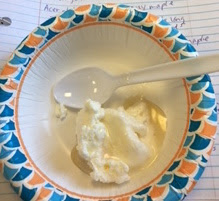A close eye is kept on the thermometer in the final moments of syrup production.
I "finished" our first pint of syrup in class this past Monday and we were all able to enjoy warm maple syrup over ice cream. Saying syrup boils at 219 degrees Fahrenheit is a little oversimplified. In fact, maple syrup boils 7.1 degrees Fahrenheit above the boiling point of water. We generally think of the boiling point of water as 212 degrees Fahrenheit but this is a moving target. Elevation and barometric pressure can affect the boiling point of water and thus move the syrup target up or down.
Using they hydrometer to confirm our syrup is finished
Sap that has not yet reached the sugar concentration required to be called syrup can spoil quickly so it is important to confirm in a couple of ways that the syrup is truly finished. Another measurement that can confirm we have reached syrup is density. A nifty little tool known as a hydrometer uses principles of buoyancy to measure the density of a fluid. Maple sugar producers use a hydrometer calibrated for syrup to help confirm their product is finished. After hitting 219 degrees Fahrenheit in class, we tested our syrup using a hydrometer and confirmed we were done.
Filtering the final product
Finally, the hot syrup was poured through a filter consisting of a synthetic filter paper and multiple layers of cheese cloth. This removes all of the mineral, mostly potassium nitrate, that has concentrated in the syrup along with the sugar. Maple producers call this cloudy mineral sugar sand or niter. Finished syrup should be free of sugar sand and bottled hot to ensure there is no contamination in the container. We let our new jug of syrup cool for a few minutes before enjoying a long awaited taste of spring.
A sweet reward




No comments:
Post a Comment